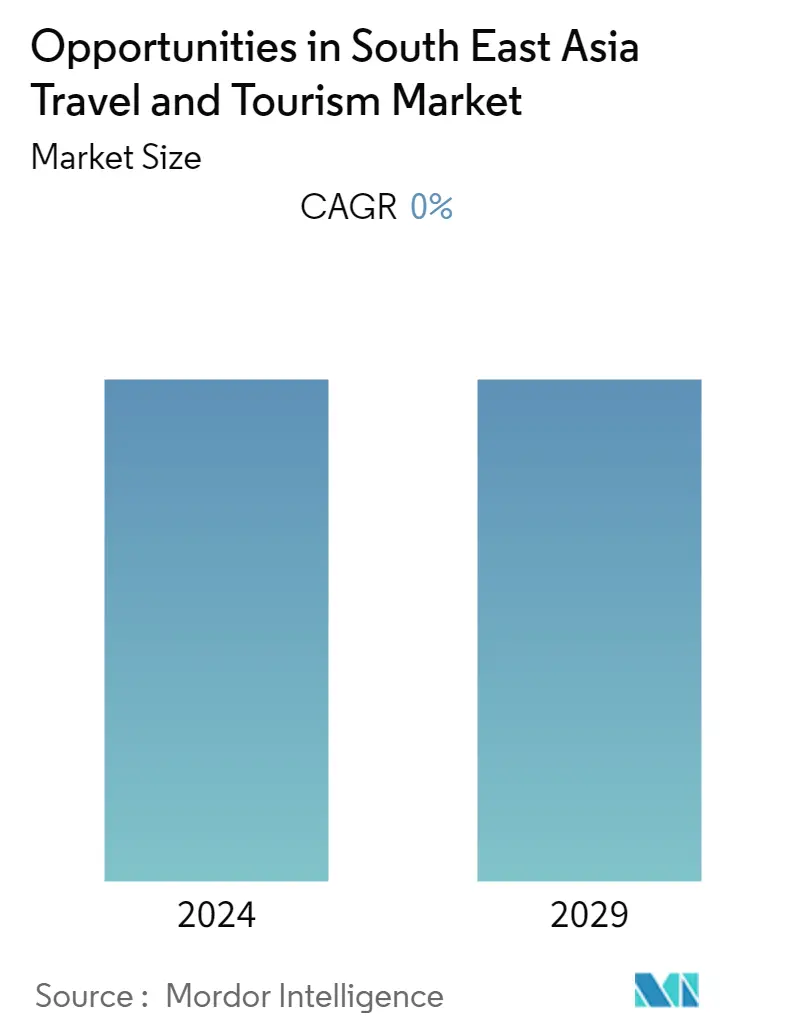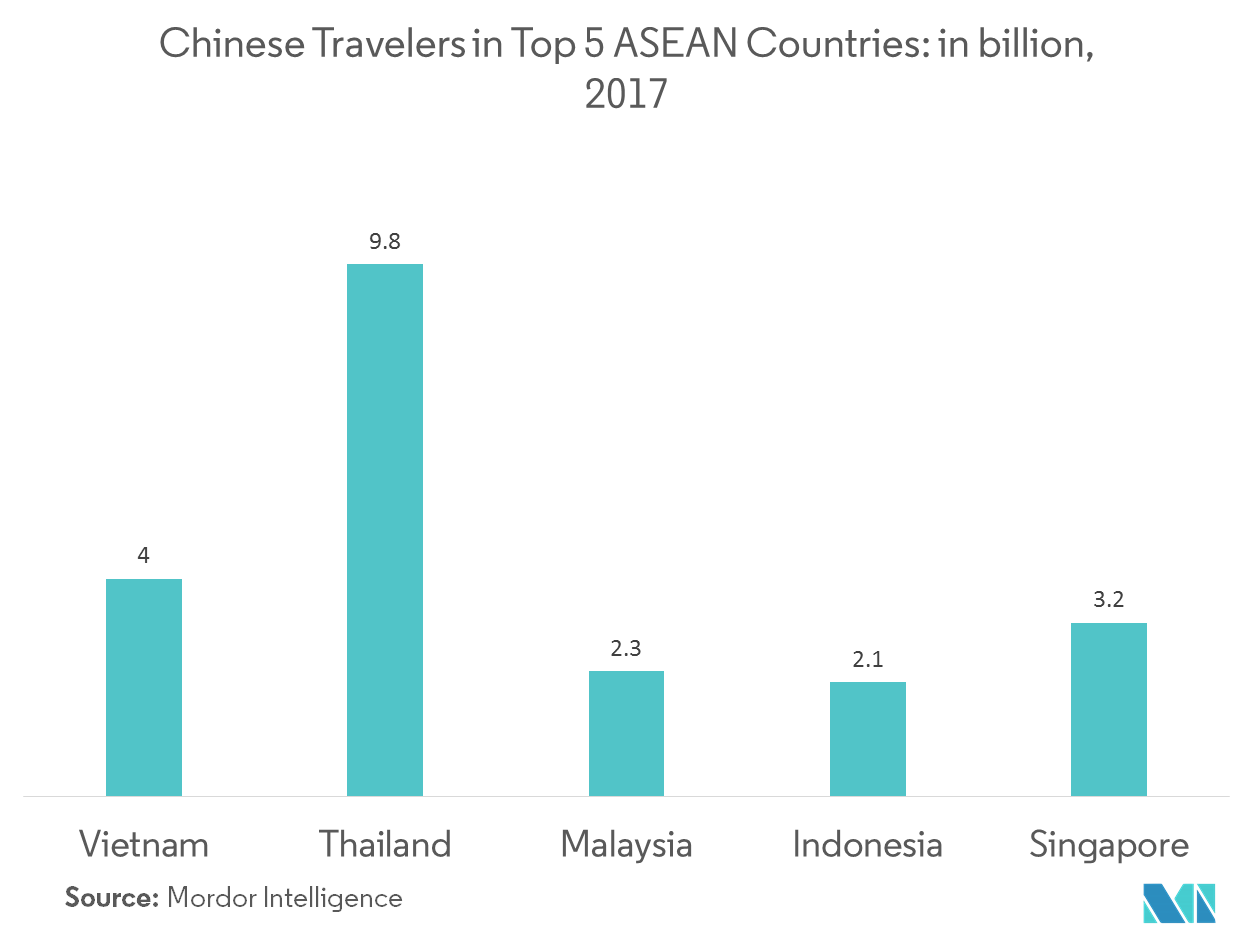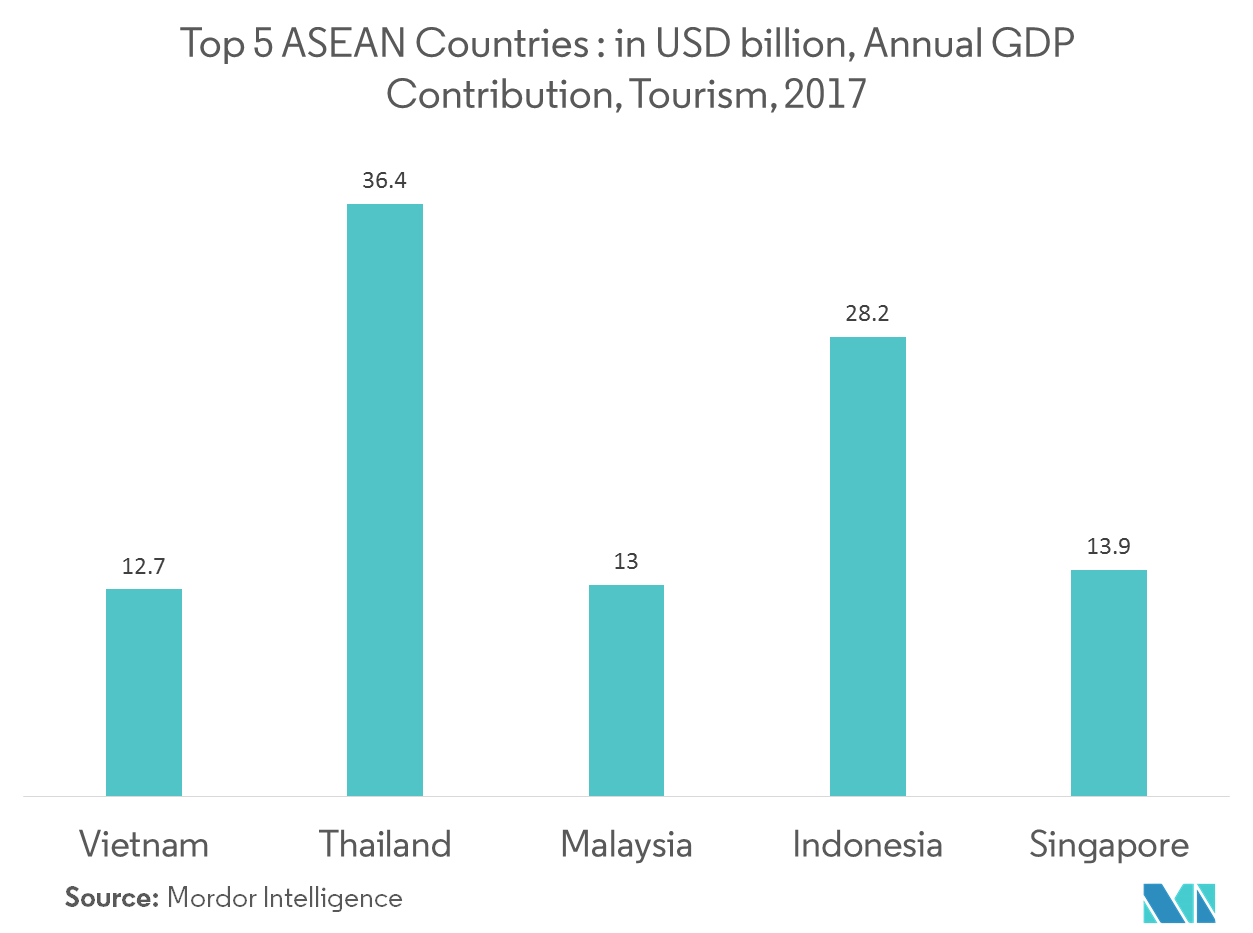Southeast Asia Travel Market Size

| Study Period | 2019 - 2029 |
| Base Year For Estimation | 2023 |
| Forecast Data Period | 2024 - 2029 |
| Historical Data Period | 2019 - 2022 |
| CAGR | 0.00 % |
| Market Concentration | Low |
Major Players
*Disclaimer: Major Players sorted in no particular order |
Southeast Asia Travel Market Analysis
The travel and tourism market in South East Asia is segmented by Country, Type of Travel and by Mode of travel. The market is expected to observe growth due to the increasing outbound travel byyoung population within the region as well as growing inbound travel to the region.
- The growing government focus on the tourism industry in the region s a major driver for the industry.ASEAN TourismStrategicPlan2016-2025 is aimed to improve the tourism quality as well as the destinations in the region.
- China is the leading country to travel in the ASEAN region due to the proximity and availability of heavily discounted travel packages along with eased visa applications.
Southeast Asia Travel Market Trends
This section covers the major market trends shaping the South East Asia Travel & Tourism Market according to our research experts:
Growing Chinses Tourists in ASEAN Region
There are several reasons for the sky-rocketing numbers of Chinese tourists during the last 15 years. China is the most populous country in the world with 1.41 billion people and they constitute roughly one-fifth of the global population. China, whose per capita GDP—according to the World Bank– was US$8,827 in 2017, has a 430-million strong middle class and 60 percent of its 1.41 billion people live in urban areas. Due to the constant increase in personal incomes, most of the middle-class people have developed a special passion for tourism and shopping. Internet or online technology has made it easy to book plane or cruise tickets and hotel accommodation. A relaxation of visa requirements for Chinese tourists, including visa-on-arrival, by many countries, has prompted Chinese to travel abroad. Affordable airline tickets and connectivity have made overseas travel easier. The creativity of Chinese tour operators in organizing efficient and highly professional group tours, including the controversial “zero-dollar” tours, in which tourists pay all expenses in advance and shop at designated places, paying using online Chinese companies. All these factors, especially rising incomes, have led to an unprecedented boom in the Chinese outbound tourism sector.
In Southeast Asia, all members of ASEAN have been enjoying a boom in their tourist sectors, due to the huge surge in the number of Chinese tourists. There are two reasons, the first is the rise of incomes in both China, which, as we have seen, emerged as the second-largest economy with a huge middle class during the same period, and also in ASEAN, which contributes more than 40% of international tourists in intra-ASEAN tourism. The second is the affordability of air travel, thanks to the mushrooming of budget airlines. Chinese tourists have been flocking to Southeast Asian countries, which are conveniently located for China. For example, Thailand has been receiving more than 10 million tourists from China annually over the last three years. Almost one-third of Thailand’s 35.38 million foreign tourists came from China in 2017. The same trend is observed for the other ASEAN countries which is a driving factor for the ASEAN Tourism sector.

Government Developing plans for Tourism Growth
The diverse range of recreational activities and travel options in the ASEAN region has made it a top tourist destination. According to the World Tourism and Travel Council (WTTC), the tourism sector contributed a mountainous USD 119.7 billion in 2016 to the region. Thus to improve and maintain its growth prospects, the ASEAN countries have been investing and planning to become a major global tourism region.
According to ASEAN Tourism Strategic Plan 2016-2025, the regional bloc has pledged that by 2025, it would “be a quality tourism destination offering a unique, diverse ASEAN experience, and will be committed to responsible, sustainable, inclusive and balanced tourism development, so as to contribute significantly to the socioeconomic well-being of ASEAN people.” The 21st Meeting of ASEAN Tourism Ministers which was held in January 2018 in conjunction with the ASEAN Tourism Forum (ATF) 2018 and saw the adoption of a number of new declarations along with plans associated to boosting and complementing the current strategic plan of ASEAN countries. The plan includes developing ASEAN tourism products, enhancing connectivity, and expanding the ASEAN regional destination-marketing program.
Among the few steps being taken to improve tourism in the plan is enhancing connectivity for tourism, an ASEAN Framework Agreement on the Facilitation of Cross Border Transport of Passengers by Road Vehicles (CBTP) being signed in 2018. This framework will facilitate the unified cross-border movement of tourists and will also promote over-land travel between ASEAN states. Another plan in works is the collaboration between five of ASEAN member states namely Cambodia, Lao PDR, Myanmar, Thailand, and Vietnam along with China in the formation of the Lancang Mekong Tourist Cities Cooperation Alliance.

Southeast Asia Travel Industry Overview
The market is expected to be fragmented with the presence of a large number of online and direct players in the region. There are major international players like Expedia, to local players like Vetravel operating in the industry.
Southeast Asia Travel Market Leaders
-
Agoda
-
Airbnb
-
Booking.com
-
Vietravel
-
Mayflower Holidays Sdn Bhd
*Disclaimer: Major Players sorted in no particular order

Southeast Asia Travel Market Report - Table of Contents
-
1. INTRODUCTION
-
1.1 Study Deliverables
-
1.2 Study Assumptions
-
1.3 Scope of the Market
-
-
2. RESEARCH METHODOLOGY
-
2.1 Analysis Methodology
-
2.2 Research Phases
-
-
3. EXECUTIVE SUMMERY
-
4. MARKET INSIGHTS AND DYNAMICS
-
4.1 Drivers
-
4.2 Constraints
-
4.3 Opportunities
-
4.4 Porter's Five Forces Analysis
-
4.5 Insights on Online Travel Market in ASEAN region
-
4.6 Insights on Outbound Travel from Other Regions
-
-
5. MARKET SEGMENTATION
-
5.1 BY COUNTRY
-
5.1.1 Thailand
-
5.1.2 Vietnam
-
5.1.3 Singapore
-
5.1.4 Brunei
-
5.1.5 Indonesia
-
5.1.6 Malaysia
-
-
5.2 BY TYPE OF TRAVEL
-
5.2.1 Inbound
-
5.2.2 Outbound
-
-
5.3 BY MODE OF TRAVEL
-
5.3.1 Air
-
5.3.2 Road
-
5.3.3 Sea
-
-
-
6. INVESTMENT IN THE COUNTRY
-
7. KEY COMPANY PLAYERS
-
7.1 A Little Heaven On Earth Company Limited
-
7.2 Vietravel
-
7.3 Panorama JTB Tours Indonesia
-
7.4 Mayflower Holidays Sdn Bhd
-
7.5 Fortune Travel Pte Ltd,
-
7.6 Traveloka Pte. Ltd.
-
7.7 Panorama Destination, Tbk.*
-
-
8. APPENDIX
-
9. DISCLAIMER
Southeast Asia Travel Industry Segmentation
The South East Asia Travel and Tourism industry report covers information about the countries in the region, the type of travel, and the mode of travel. Additionally, the report will cover insights on Online travel market in the region, driver and restrains to the market. The report will also cover information on some of the major players active in the region.
| BY COUNTRY | |
| Thailand | |
| Vietnam | |
| Singapore | |
| Brunei | |
| Indonesia | |
| Malaysia |
| BY TYPE OF TRAVEL | |
| Inbound | |
| Outbound |
| BY MODE OF TRAVEL | |
| Air | |
| Road | |
| Sea |
Southeast Asia Travel Market Research FAQs
What is the current Opportunities in South East Asia Travel and Tourism Market size?
The Opportunities in South East Asia Travel and Tourism Market is projected to register a CAGR of 0% during the forecast period (2024-2029)
Who are the key players in Opportunities in South East Asia Travel and Tourism Market?
Agoda, Airbnb, Booking.com, Vietravel and Mayflower Holidays Sdn Bhd are the major companies operating in the Opportunities in South East Asia Travel and Tourism Market.
What years does this Opportunities in South East Asia Travel and Tourism Market cover?
The report covers the Opportunities in South East Asia Travel and Tourism Market historical market size for years: 2019, 2020, 2021, 2022 and 2023. The report also forecasts the Opportunities in South East Asia Travel and Tourism Market size for years: 2024, 2025, 2026, 2027, 2028 and 2029.
What are the key opportunities for the growth of the South East Asia Travel and Tourism Market?
The key opportunities for the growth of the South East Asia Travel and Tourism Market are a) Growing demand for sustainable tourism, catering to niche tourism segments b) Leveraging digital marketing and online booking platforms c) Infrastructure development for better connectivity, and establishing collaborative partnerships within the industry
Southeast Asia Travel Industry Report
The tourism sector in Asian countries is experiencing rapid growth, particularly in Southeast Asia. This growth is driven by increasing outbound travelers from China and South East Asia, an improving middle class, and a young generation. Market segmentation highlights the diverse array of destinations, from natural landscapes to vibrant urban areas, contributing to the market's expansion.
Market research indicates that rising disposable incomes and improved infrastructure are significant factors boosting the tourism industry. Industry trends show a shift from conventional sightseeing to cultural immersion and eco-friendly options, reflecting evolving consumer preferences. The industry's growth is supported by technological advancements that streamline travel planning and booking through digital platforms, enhancing market visibility and convenience for travelers.
Industry analysis reveals that despite challenges such as environmental concerns and infrastructure limitations, there are substantial growth opportunities in niche segments like wellness, adventure, and culinary tourism. Industry information and market data underscore the importance of collaboration among stakeholders, including local governments and businesses, to leverage digital transformation and integrate tourism market statistics into strategic planning.
The market overview and market forecast suggest a positive outlook for the tourism sector in Southeast Asia, with continuous growth expected. Industry reports and market predictions emphasize the need for sustainable practices to ensure long-term prosperity. The market review also highlights the role of report pdfs and research companies in providing valuable insights for industry stakeholders.
Overall, the tourism market in Southeast Asia is poised for significant growth, driven by industry trends, market segmentation, and the increasing demand for unique and authentic travel experiences. The industry's outlook remains positive, with market leaders and industry research playing crucial roles in shaping its future.



